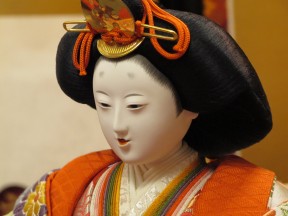A few Japanese events held in February and March, symbolize our anticipation of Spring. We have two major events, Setsubun and Girl’s Festival. Setsubun is usually held at the beginning of February, either on the 3rd or 4th, at shrines or homes. Setsubun means division of seasons, and there are four divisions in Japan according to four seasons, but today only Spring Setsubun survives. People used to believe that evil spirits would appear on these days , so they must be driven away.
People gather at a shrine, and priests in traditional kimonos spread sacred soy beans against those evil spirits and people gather as many beans as the years of their age. If you eat as many beans as the years in your age, or one extra, you will be healthy and protected from evil spirits the whole year. Beans must be roasted but the reason for this is funny. Originally, those beans were raw, but people were not able to pick them and eat because those thrown to evil spirits were not clean and people should leave them as they were. In time, fresh beans would sprout which took time to remove, so roasted beans were preferred.

One month after Setsubun, on March 3, when Spring is drawing nearer, we have Girls’ Festival, which has a 700-year long tradition. It seems to have begun within noble families for daughters to play house. There are some variations of dolls’ styles or meanings.
My parents and my husband’s parents gave us money when our first daughter was born. My husband chose a very elegant Ohinasama, emperor and empress dolls, clad in gorgeous kimonos in the style of about 800 years’ ago. The set also came with a polished floor, golden back screen, lantern and lacquer ware treasure boxes.
My neighbor’s Ohinasama is far more gorgeous and was made more than a 100 years ago. Their’s has seven or eight staircases, on which are arranged three court ladies, five musicians, two prime ministers along with tiny furniture and gold dishes inlayed with black lacquer ware. Ohinasamas were an important part of the marriage trousseau for noble girls.
There is the standing Ohinasama and is prayed to, for the girl’s health, safety, and prosperity. Ohinasama made of paper is floated in the river, so that ill fortune will be carried away from her. Usually girls have a big party to celebrate the day with delicious meal and sweet sake. Again, another style of Ohinasama is where many kinds of toys made of cloth are hung from the ceiling and it is a very cheerful sight.
We pray for daughters’ happiness, health, and as a special prayer, we wish for a good husband for them. We have continued displaying our Ohinasama every year on the shelf so that they will take care of our daughters – and they did. Three of four daughters have found very good husbands, and the last has a steady boyfriend. We have much to appreciate and thank for the warm relationship between our Ohinasama and our family!

